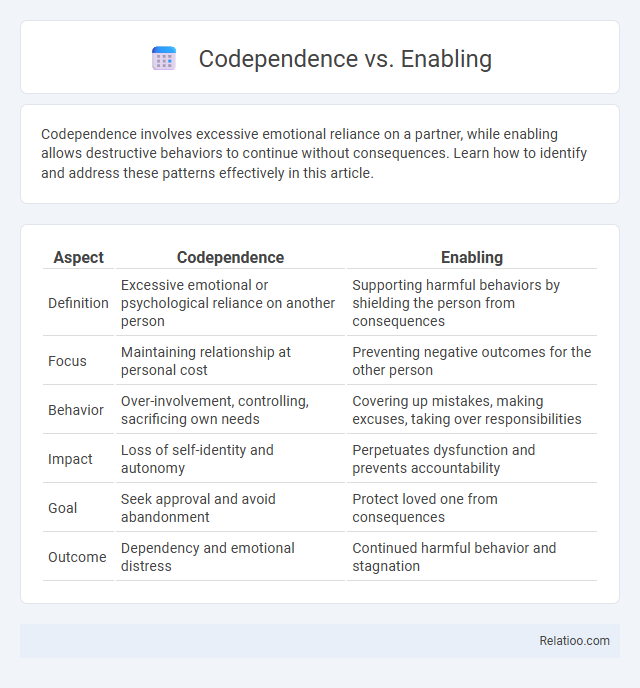Codependence involves excessive emotional reliance on a partner, while enabling allows destructive behaviors to continue without consequences. Learn how to identify and address these patterns effectively in this article.
Table of Comparison
| Aspect | Codependence | Enabling |
|---|---|---|
| Definition | Excessive emotional or psychological reliance on another person | Supporting harmful behaviors by shielding the person from consequences |
| Focus | Maintaining relationship at personal cost | Preventing negative outcomes for the other person |
| Behavior | Over-involvement, controlling, sacrificing own needs | Covering up mistakes, making excuses, taking over responsibilities |
| Impact | Loss of self-identity and autonomy | Perpetuates dysfunction and prevents accountability |
| Goal | Seek approval and avoid abandonment | Protect loved one from consequences |
| Outcome | Dependency and emotional distress | Continued harmful behavior and stagnation |
Understanding Codependence: Key Characteristics
Codependence involves an excessive emotional or psychological reliance on a partner, often characterized by a need to control or fix others to maintain self-worth. Key characteristics include low self-esteem, difficulty setting boundaries, and a chronic fear of abandonment, leading to compulsive caretaking behaviors. Unlike enabling, which actively supports destructive behaviors, codependence centers on an unhealthy need for approval and identity through another's problems.
Defining Enabling Behaviors
Enabling behaviors involve actions that unintentionally support or perpetuate another person's dysfunctional habits, often seen in relationships affected by codependence. These behaviors can include making excuses for someone's mistakes, taking over their responsibilities, or shielding them from consequences, which ultimately hinders their personal growth and accountability. Understanding the distinction between enabling and codependence helps you recognize the boundaries necessary to foster healthier interactions and promote individual responsibility.
Codependence vs Enabling: Core Differences
Codependence involves excessive emotional reliance on another person, often leading to a loss of personal identity, while enabling refers to behaviors that unintentionally support or encourage another person's harmful habits or dysfunctions. You must recognize that codependence centers on managing your own emotions through another, whereas enabling focuses on facilitating or protecting the other person's destructive behaviors. Understanding these core differences is crucial for establishing healthier boundaries and promoting recovery.
Emotional Impacts of Codependence
Codependence often leads to emotional exhaustion, characterized by low self-esteem, anxiety, and difficulty setting boundaries. Enabling behaviors, which may seem helpful, actually reinforce unhealthy patterns and prevent your loved one from taking responsibility. Emotional impacts of codependence include chronic stress and feelings of guilt, confusion, and resentment that hinder genuine emotional growth.
How Enabling Hinders Growth
Enabling behaviors involve shielding individuals from the natural consequences of their actions, which stunts personal growth and accountability. Codependence often fuels enabling by creating unhealthy dependencies where one person's needs dominate the relationship. Distinguishing enables from codependence clarifies how excessive support can prevent the development of self-reliance and emotional resilience.
Recognizing Codependent Relationships
Recognizing codependent relationships involves identifying patterns where one person excessively relies on another for approval, identity, or emotional support, often leading to a loss of autonomy. Enabling behaviors sustain unhealthy dynamics by shielding individuals from the consequences of their actions, which perpetuates dependency and dysfunction. Distinguishing codependence from enabling requires understanding that codependence is rooted in emotional needs and self-worth issues, while enabling directly facilitates the other person's problematic behavior.
Signs You Might Be Enabling
Recognizing signs you might be enabling is crucial for maintaining healthy boundaries and fostering independence in relationships. Enabling often involves making excuses for someone's harmful behavior, taking on their responsibilities, or shielding them from consequences, which can blur the line with codependence. Your awareness of these patterns can help break the cycle and promote genuine support without sacrificing your well-being.
Breaking the Codependence Cycle
Breaking the codependence cycle requires recognizing patterns of excessive emotional reliance and unhealthy boundary violations that perpetuate enabling behaviors. Setting and maintaining firm boundaries disrupts enablers' tendencies to shield others from consequences, fostering healthier interpersonal dynamics. Emphasizing self-care and seeking professional support helps individuals regain autonomy and promotes sustainable, balanced relationships.
Healthy Boundaries: Pathway to Recovery
Healthy boundaries distinguish codependence from enabling by promoting self-respect and emotional autonomy while supporting others without overstepping personal limits. Establishing clear limits helps individuals avoid sacrificing their own needs or becoming enablers who foster dependence through excessive support or control. Recovery hinges on recognizing unhealthy patterns, embracing assertiveness, and cultivating boundaries that balance empathy with personal well-being.
Seeking Help: Support and Resources
Seeking help for codependence involves recognizing unhealthy relationship patterns and accessing specialized therapy, such as cognitive-behavioral therapy (CBT) or support groups like Co-Dependents Anonymous (CoDA). Enabling behaviors require intervention strategies that focus on setting boundaries and learning to empower loved ones rather than rescuing them, with resources including family counseling and educational workshops. Your journey to recovery is supported by a wide range of professional counselors, online forums, and self-help materials designed to address both codependence and enabling for sustainable emotional health.

Infographic: Codependence vs Enabling
 relatioo.com
relatioo.com